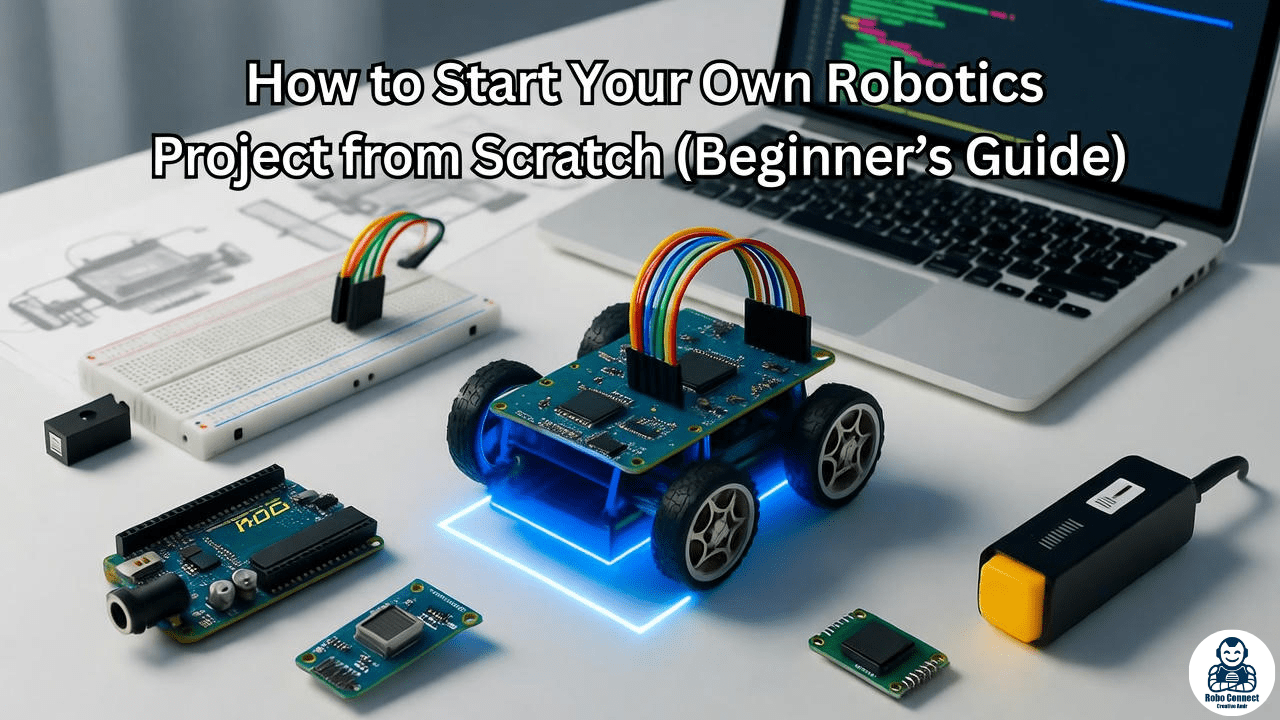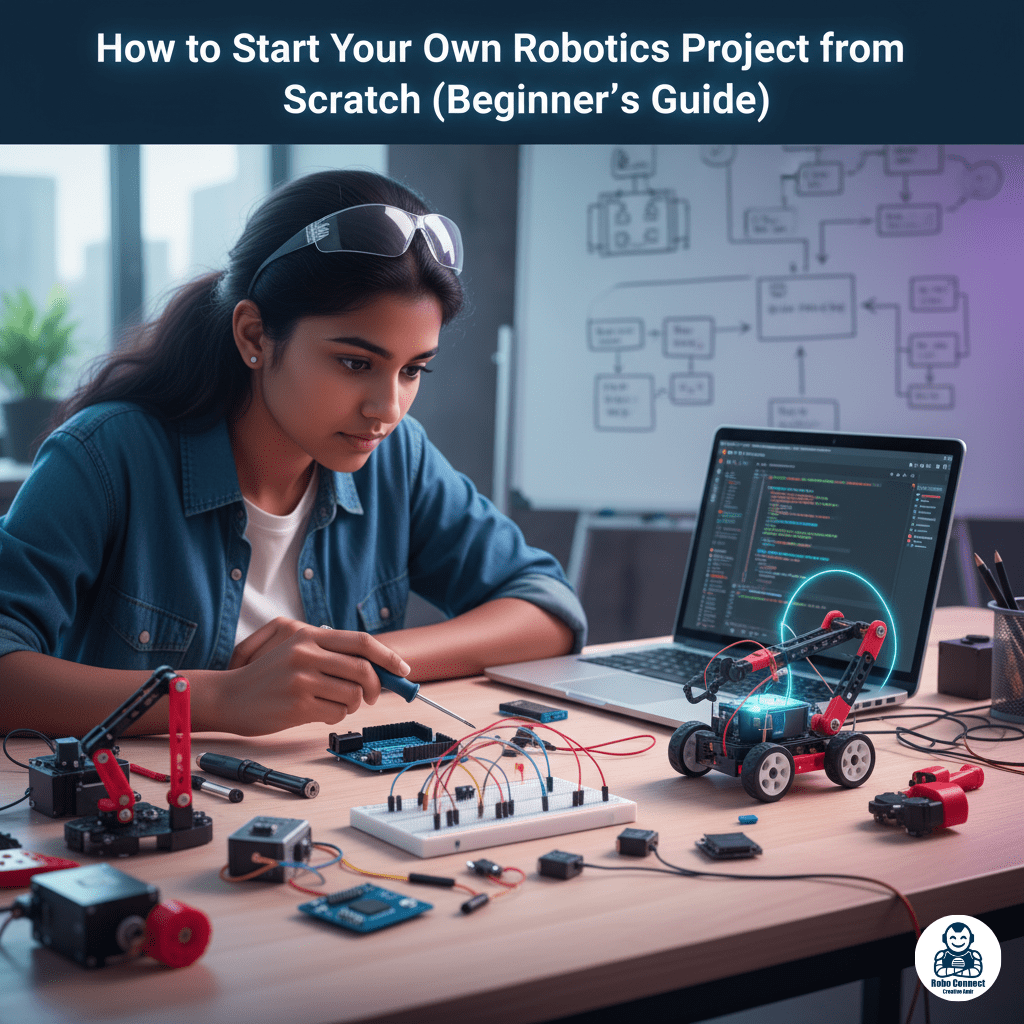Introduction
Building your own robot may sound intimidating, but it doesn’t have to be. In fact, every great robotics expert started with a simple DIY project that slowly grew in complexity.
Whether you’re a student, hobbyist, or future engineer, starting a robotics project from scratch teaches you:
- Electronics
- Coding
- Mechanical design
- Problem-solving
In this guide, you’ll learn a step‑by‑step roadmap to plan, design, and build your first robotics project.
Step 1: Define a Simple Goal
Don’t jump straight into humanoids or autonomous drones on day one.
Start with clear, beginner‑friendly goals, like:
- A Line Follower Robot (follows black path using IR sensors).
- An Obstacle Avoidance Robot (ultrasonic sensor + wheels).
- A Bluetooth Controlled Car (drive with your phone).
Rule of thumb: Start small → get wins → then scale.
Step 2: Choose the Brain (Microcontroller/Computer)
- Arduino Uno/Nano:
- Best for beginners.
- Easy to program, tons of online tutorials.
- Perfect for sensor/motor projects.
- ESP8266/ESP32:
- Built‑in Wi‑Fi/Bluetooth.
- Great for IoT smart cars & remote control.
- Raspberry Pi:
- Full microcomputer (runs Linux, Python, AI).
- Perfect for camera vision robots & AI.
Start with Arduino → scale later to ESP/Raspberry Pi as projects get advanced.
Step 3: Pick Your Robot Type
- Wheeled Car Robot:
- Simplest design → beginner kits widely available.
- Robotic Arm:
- Learn servo control + kinematics.
- Drone:
- Advanced (requires flight controllers + 3D printing).
- Humanoid:
- Complex → recommended after mastering basics.
For your first real build, start with wheeled robots.
Step 4: Gather Components
Typical beginner kit includes:
- Chassis (plastic, metal, or 3D‑printed).
- DC Motors & Wheels (or servos).
- Motor Driver (L298N, L293D) to drive motors safely.
- Sensors (IR, ultrasonic, gyro).
- Microcontroller (Arduino/ESP/RPi).
- Battery (Li‑Po or Li‑ion pack + BMS).
- Breadboard/jumper wires OR custom PCB.
Tip: Buy an Arduino Robotics Starter Kit to save shopping stress.
Step 5: Build & Wire the Robot
- Assemble the chassis.
- Mount motors + wheels + castor wheel.
- Connect motors to driver + driver to Arduino.
- Add sensors at the front.
- Mount power supply securely.
Step 6: Write the Code
- Blink an LED (basic test).
- Drive motors forward/backward.
- Add sensor reading (IR or Ultrasonic).
- Combine everything into robot logic.
Simple Logic Example (Obstacle Robot):
text
If distance > 15 cm → Move forward
If distance ≤ 15 cm → Stop + turn left
Start small → expand as you go.
Step 7: Test, Debug & Improve
No robot works perfectly on first try (trust me ).
- Check power issues (motors need stable current).
- Verify sensor placement (adjust angles).
- Tune delays & thresholds in code.
Then… iterate. Each fix teaches you something new.
Step 8: Scale Up
Once your first bot works:
- Add Bluetooth → smartphone‑controlled robot.
- Add More Sensors (line + obstacle combo).
- Add IoT → ESP32 Wi‑Fi controlled bot.
- Add Vision → Raspberry Pi + Camera AI Bot.
This is how you graduate from basic bots → smart robots → AI robotics.
Tips for Success
- Start simple (don’t overcomplicate your first bot).
- Keep wiring neat & labeled.
- Document your project (photos, schematics, code).
- Join online communities (Reddit Robotics, Arduino Forum).
- Enter robotics competitions (FIRST, RoboCup, WRO).
FAQs
Q1: Do I need soldering & PCB skills to begin?
Not necessarily — breadboards & jumper wires are fine at first. Later, PCBs make projects reliable.
Q2: How much does a beginner robot cost?
$30–50 for a simple line follower bot. $100+ for advanced builds.
Q3: Can I build robots without coding?
Basic kits exist, but eventually coding is essential to unlock possibilities.
Conclusion
Starting your first robotics project from scratch is exciting AND achievable:
- Pick a simple project (line follower, obstacle bot).
- Use Arduino or ESP as a brain.
- Add sensors + motors.
- Build → Test → Tweak → Improve.
The key is to start small, learn by building, and grow every project.
Before long, you’ll progress from basic cars → smart IoT bots → AI-powered robots.

